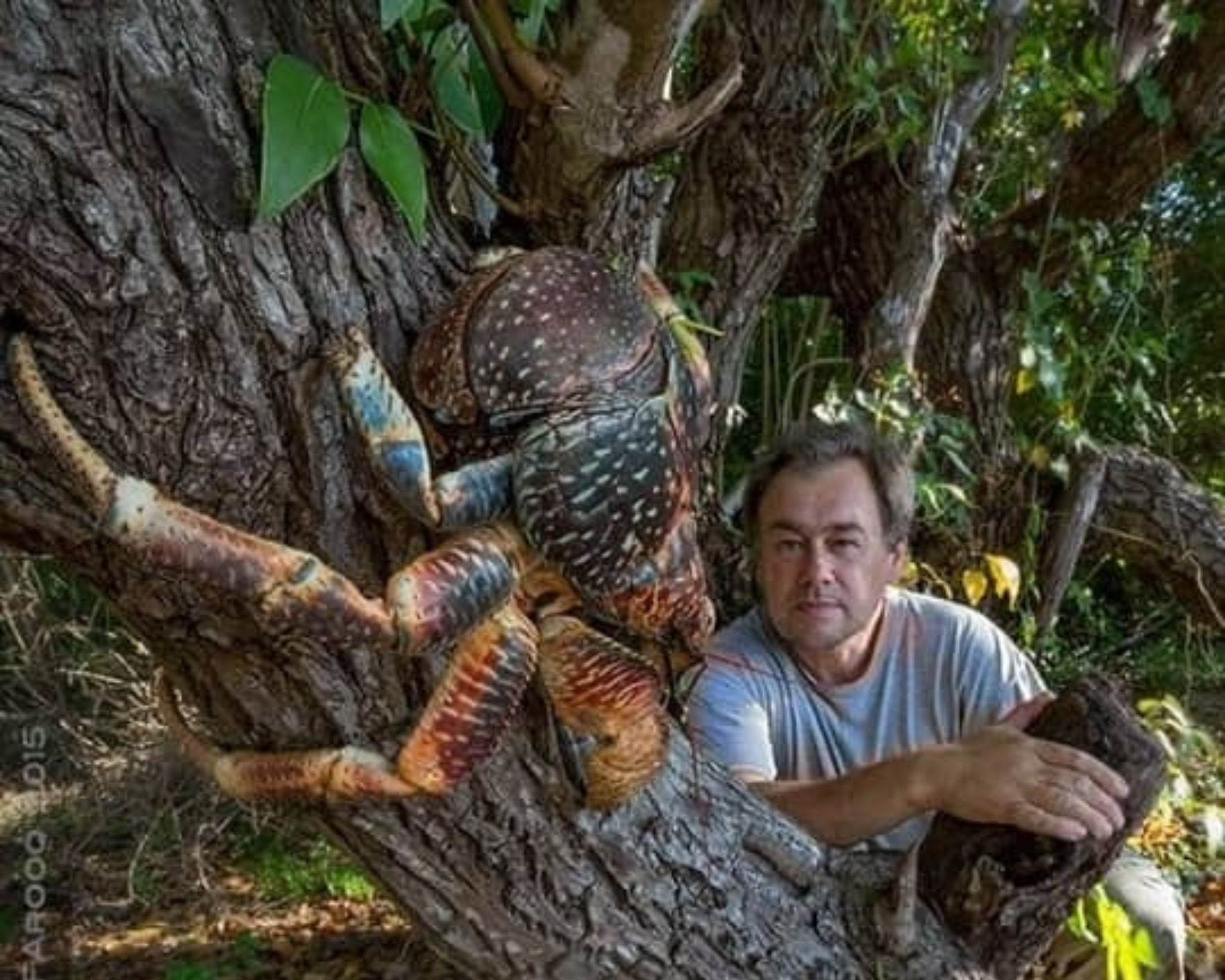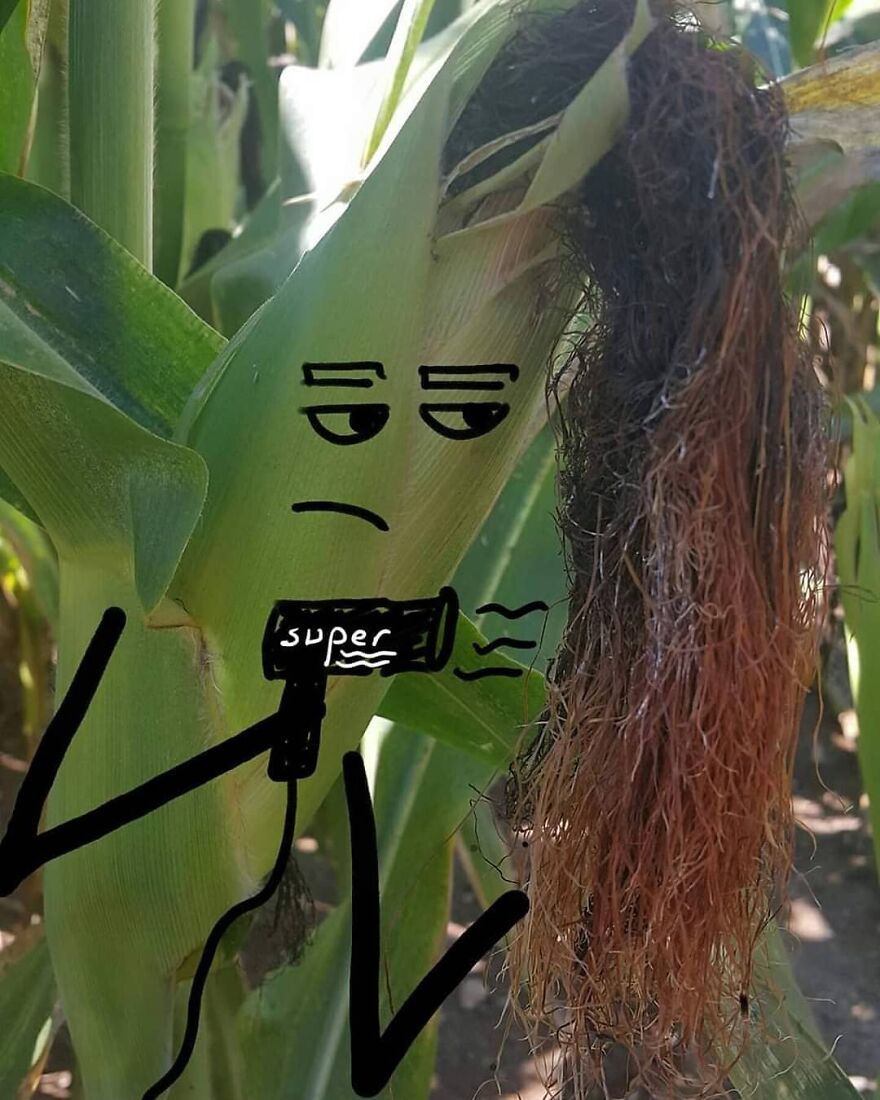The coconut crab (Birgus Latro), which may weigh up to 4.1 kilograms, holds the record for being the largest terrestrial arthropod in the world (9.0 lb). It can reach a length of up to 1 meter (3 feet 3 inches) from each tip to the tip of the leg. Its distribution is comparable to that of the coconut palm, as it can be found on islands all across the Indian Ocean and in parts of the Pacific Ocean as far east as the Gambier Islands and the Pitcairn Islands. However, it has been eradicated from the majority of regions that have a significant human population, such as mainland of Australia, Madagascar, and Zanzibar.
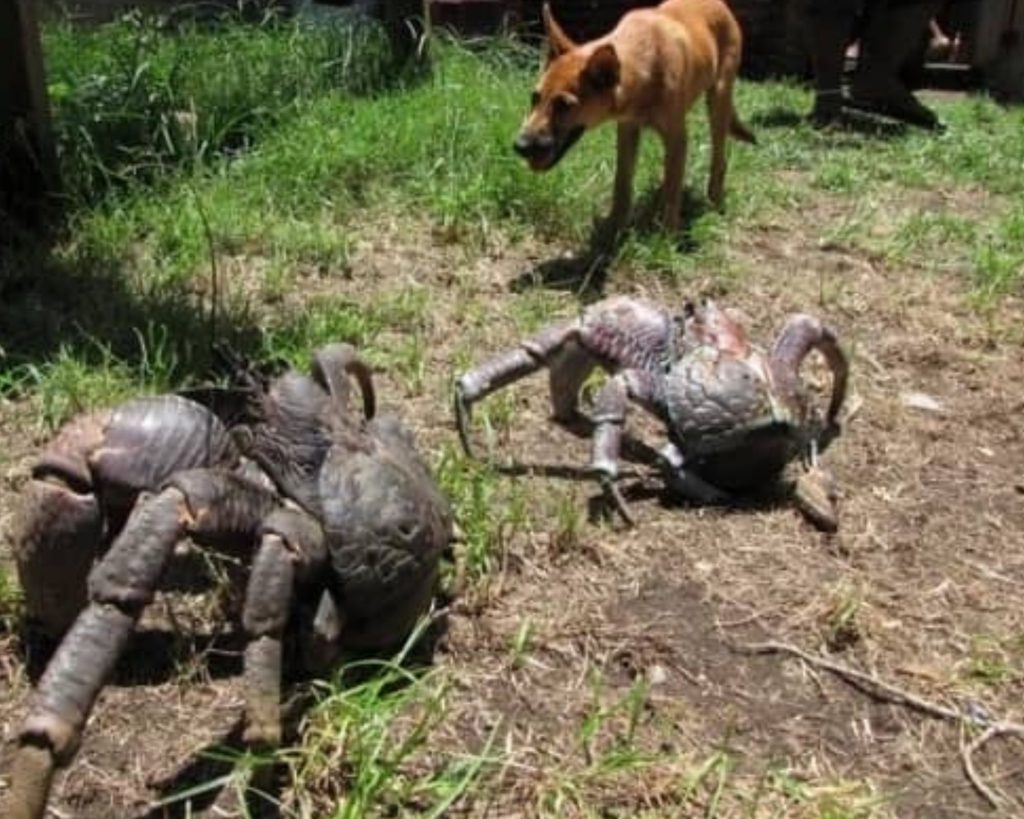
The coconut crab (Birgus latro), often known as the robber crab or palm thief, is a species of terrestrial hermit crab. With a weight of up-to 4.1 kilos, it is the world’s largest terrestrial arthropod (9 lb). When measured from the tip of one leg to the tip of the next, it has the capacity to spread out up to 1 meter (3 feet 3 inches). Similar to how the coconut palm is distributed, it can be found on islands all across the Indian Ocean as well as in areas of the Pacific Ocean as far east as the Gambier Islands and the Pitcairn Islands. However, it has been eliminated from the majority of areas with a sizable human population, such as Madagascar and mainland Australia. Coconut crabs are another creature that can be found in Zanzibar on the African coast.
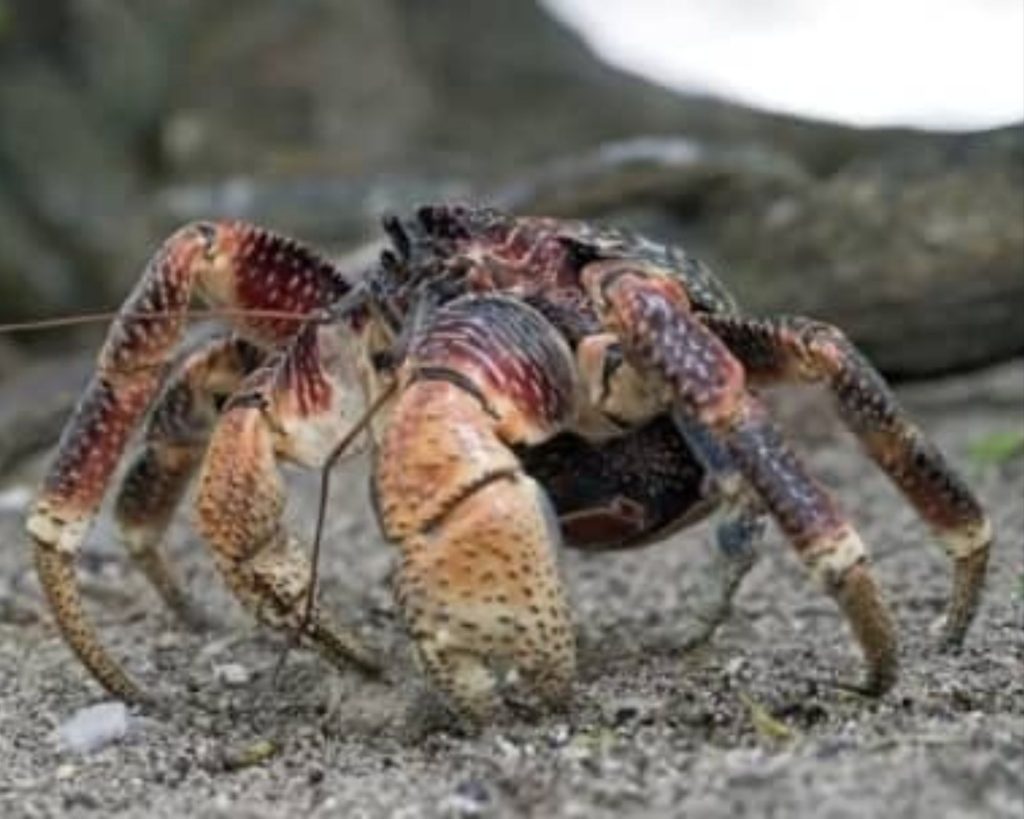
The single species of the genus Birgus is the coconut crab, which is related to land-based hermit crabs from the family Coenobita. It shows how various adaptations are required for living on land. Young coconut crabs, like other hermit crabs, carry around empty snail shells for protection; but, as they get older, they develop a strong exoskeleton on their abdomens and no longer need to do so. Coconut crabs have branchiostegal lungs, which are body organs that replace the crabs’ rudimentary gills. Breathing takes place in these lungs. Once they reach adulthood, they will inevitably die if immersed in water for a prolonged period of time. Their strong sense of smell, which evolved in a fashion akin to how insects smell, is used by them to locate prospective food sources.

Although juicy fruits, nuts, seeds, and the pith of downed trees make up the majority of an adult coconut crab’s diet, these crabs will also consume carrion and other forms of organic matter when the opportunity presents itself. They will examine and maybe take anything that is left unattended on the ground as a potential source of food, which is how they got the alternate moniker of “robber crab.” Although coconuts are commonly thought to be a key element of the diet of this species, scientific evidence suggests that this is not the case. Despite the fact that it lives in a burrow, the crab has been seen climbing up coconut and pandanus trees on camera. Although there is no evidence that crabs pick and choose which coconut fruits to eat, they may knock over-ripe fruits that would otherwise fall from the tree on their own. Climbing is an immediate escape path that crabs can take (if they are too far from their burrow) in order to avoid being eaten by larger marine gulls (when they are young) by humans or being eaten by bigger, older crabs (at any age).
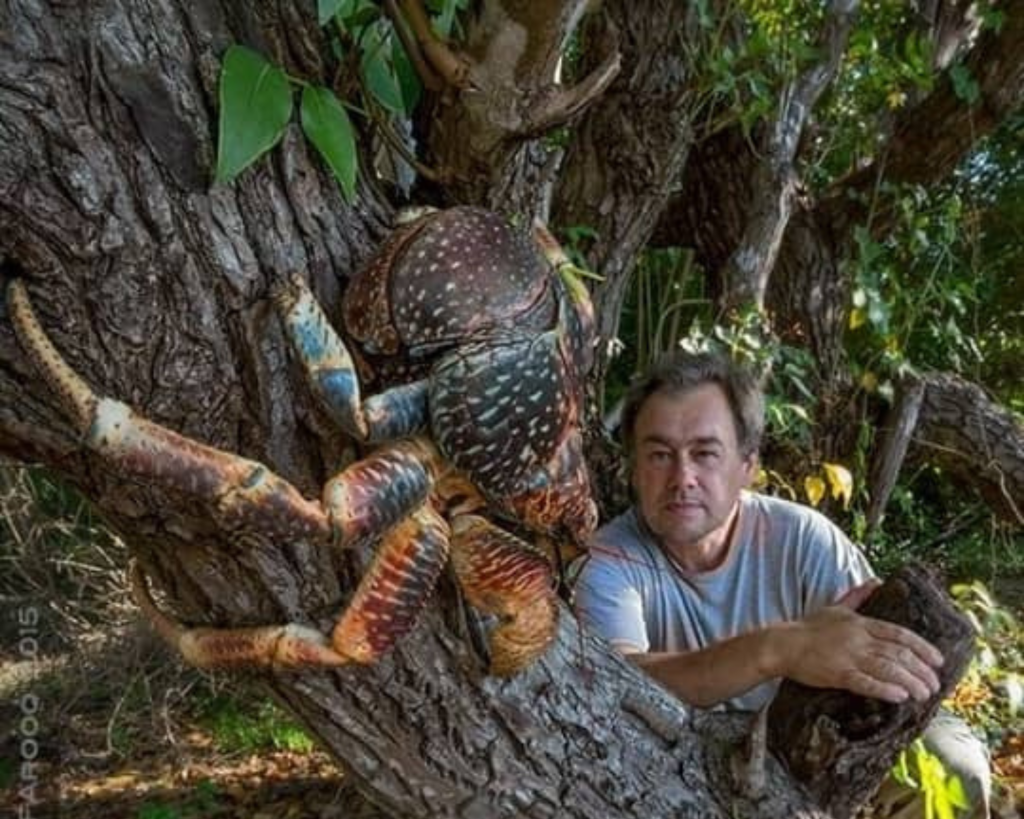
The act of mating takes place on dry land, but the females travel back to the water’s edge after mating so that they can release their fertilized eggs before heading back up the beach. After hatching, the larvae remain planktonic for about three to four weeks before sinking to the ocean floor, entering a gastropod shell, and emerging on land again. After a period of roughly five years, sexual maturity is attained, and the average life can extend well beyond 60 years. If a floating life support system is available to the larvae while they are still at sea for three to four weeks, then their chances of moving on to another area that is more suited for them are increased. Floating logs and rafts made of marine or terrestrial plants are two types of systems that are examples of those that provide such opportunities. In a similar vein, floating coconuts can be a very major component of the dispersal choices available to the crab. [4] The Miocene is when fossils of this species of crab were first discovered.
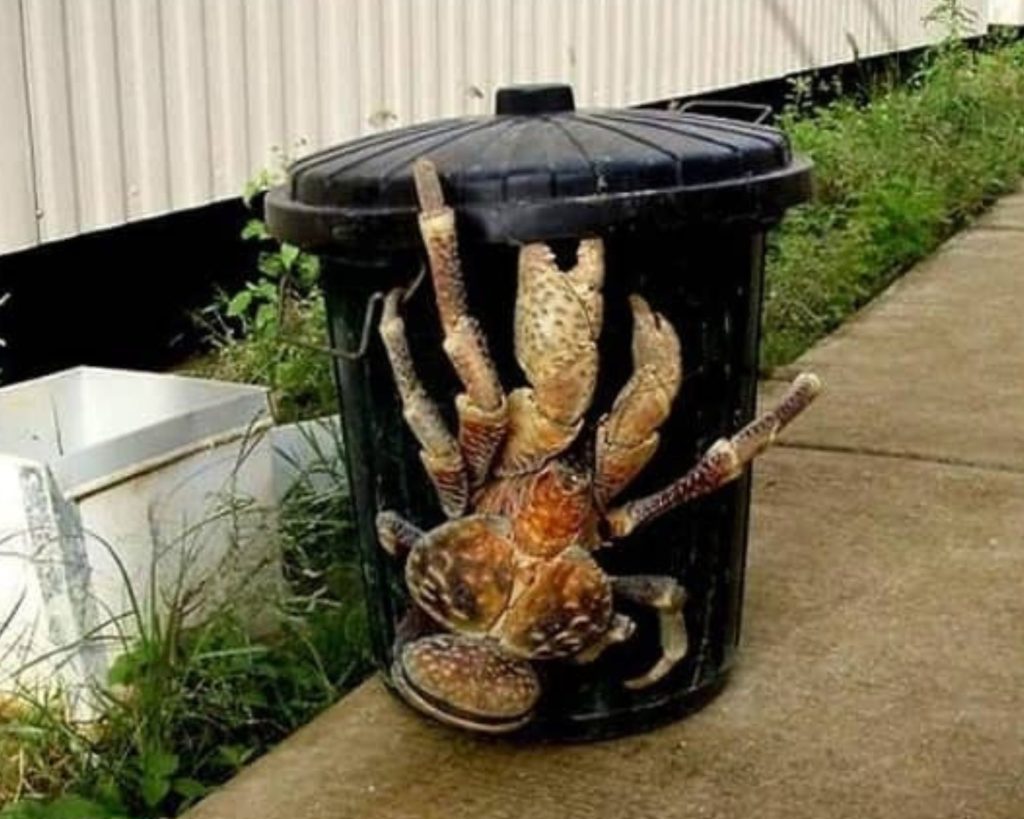
Since Francis Drake’s explorations in the area about 1580 and William Dampier’s explorations in the area around 1688, western scientists have been aware of the coconut crab. Carl-Linnaeus (1767) named the species Cancer latro, from the Latin word latro, which means “robber.” This name was derived from an account written by Georg Eberhard Rumphius (1705), who had originally referred to the animal as “Cancer crumenatus.” William Elford Leach established the genus Birgus in 1816, and it initially consisted of only one species: Linnaeus’ Cancer latro, which was afterwards rechristened as Birgus latro.

B. latro is the largest terrestrial-arthropod and, in fact, the largest terrestrial invertebrate in the world; reports about its size vary, but the majority of sources give a body length up-to 40 cm (16 in), a-weight up to 4.1 kg (9 lb), and a leg span greater than 0.91 m (3 ft), with males generally being larger than females. The length of the carapace may reach 78 millimetres (3+1/16 inches), and the width may reach up to 200 millimetres (8 in). The body of the coconut crab, like the bodies of all other decapods, is composed of a front part called the cephalothorax, which is comprised of all ten legs and an abdomen. The pair of legs that are in front of the others have enormous chelae (claws), with the left leg having larger chelae than the right. The next two pairs of legs on a coconut crab are similar to those found on other hermit crabs in that they are huge, powerful walking legs with pointed tips. These legs allow coconut crabs to climb vertical or overhanging surfaces. The fourth pair of legs is shorter and has chelae that resemble tweezers at the end. These chelae help juvenile coconut crabs to hold the interior of a shell or husk to carry for protection. Adults utilize this pair of legs for walking and climbing. The very last pair of legs are quite little, and both the males and females make use of them during the mating process. Females utilize them to care for their eggs, while males use them for mating. The third and final set of legs is often stored within the carapace, in the cavity that is home to the respiratory organs. There is a noticeable colour variation between the species that live on the various islands, which can range from bright orange to a bluish-purple colour; In most areas, blue is the predominate hue; yet, in certain locations, such as Seychelles, the majority of people have a reddish colouration.
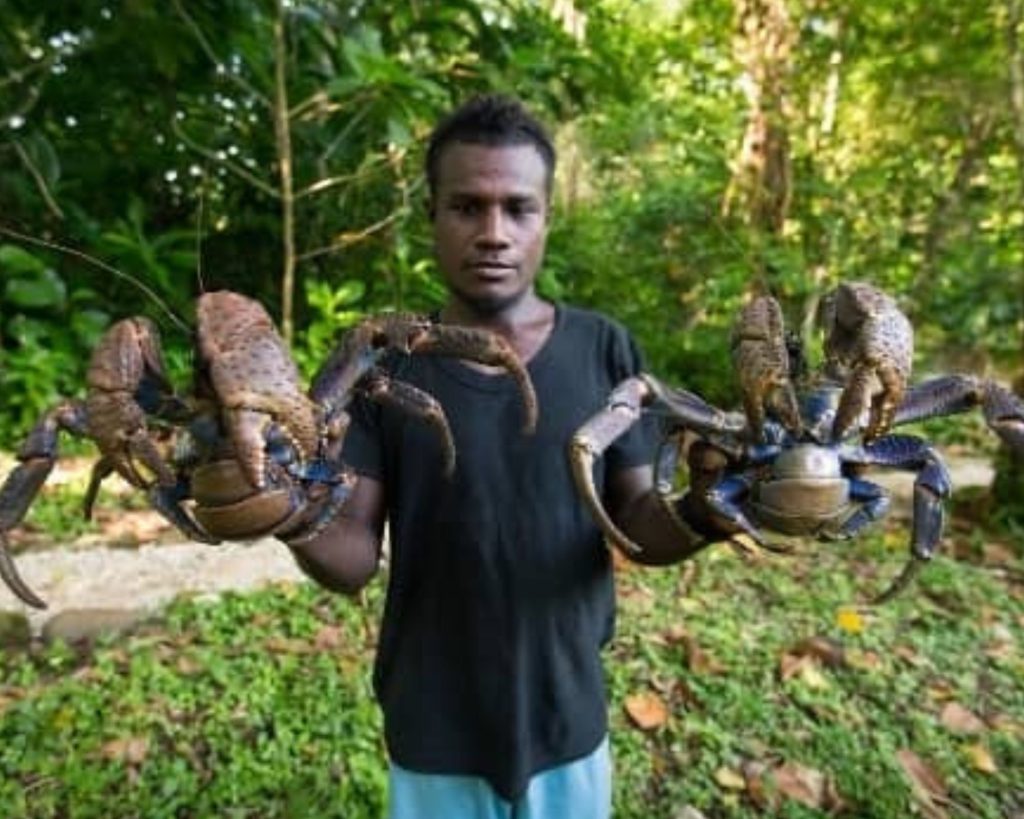
Even though B. latro is a descended species of hermit crab, and only the youngsters use repurposed snail shells to protect their sensitive abdomens. Adolescents may use broken coconut shells instead of recovered snail shells for this purpose. Adult coconut crabs, in contrast to other hermit crabs, do not carry shells; rather, they harden their abdominal terga-by depositing chitin and chalk on the surface of their bodies. This particular kind of hermit crab is able to reach a significantly larger size than other hermit crabs in the family Coenobitidae because it is not confined by the physical limits of living in a shell. The tail of B. latro is tucked under its body for safety, just like the majority of other true crabs. The coconut crab’s armoured abdomen must be shed at regular intervals in order to maintain its protective qualities and limit the amount of water it loses while living on land. Adults shed their skin once a year and dig a tunnel that can be up to one meter (3 feet and 3 inches) long to use as cover when they are exposed. Depending on the size-of-the animal, it can stay in the burrow anywhere from three to sixteen weeks. After moulting, it might take anywhere from one to three weeks for the exoskeleton to fully harden, depending on the size of the animal. During this time, the animal’s body is soft and fragile, so it stays concealed for its own safety.
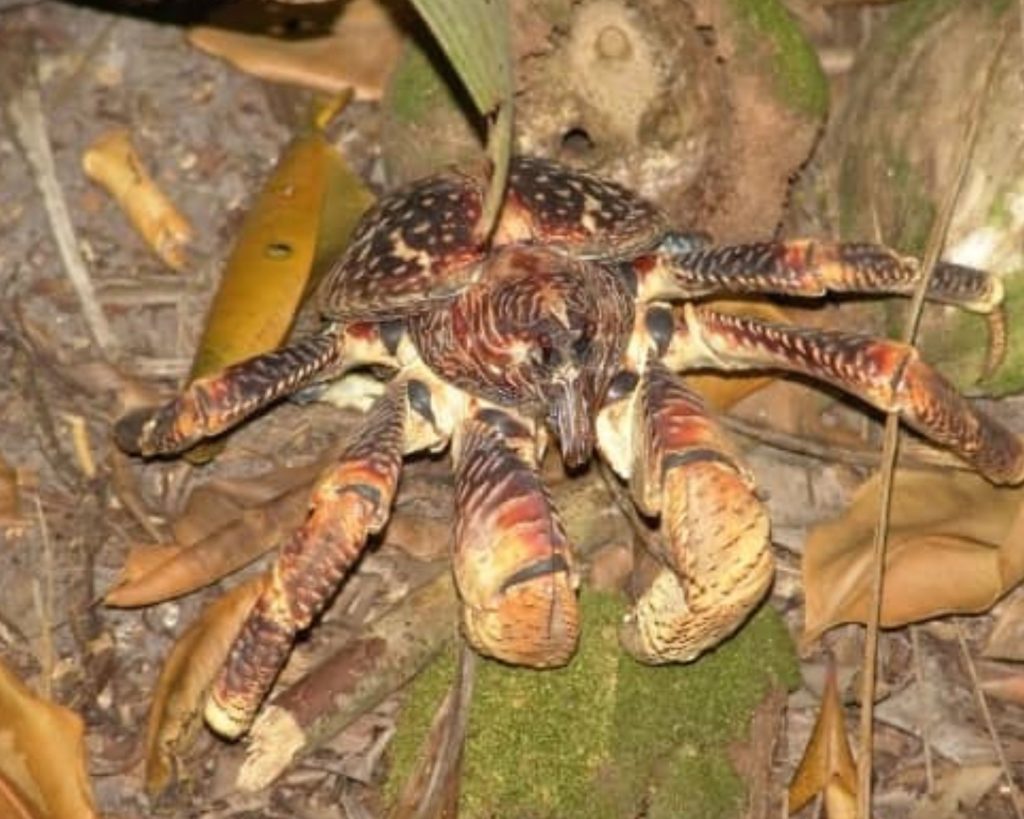
Coconut crabs are unable to swim as adults or even as larvae, and if they are submerged for more than an hour, they will perish. In order to breathe, they make use of a specialized organ known as a branchiostegal lung. This organ, which is one of the most important adaptations that the coconut crab has made to its environment, can be understood as a developmental stage that occurs between the gills and the lungs. [22] The branchiostegal lung contains a tissue that is analogous to the tissue that is present in the gills, but it is more suited for the absorption of oxygen from the air than from the water. This organ is expanded-laterally and is evaginated to increase its surface area; located in the cephalothorax, it is optimally placed to reduce both-the-blood/gas diffusion distance and the return distance of oxygenated-blood to the pericardium. This organ is expanded-laterally and is evaginated to increase its surface area. Coconut crabs utilize their last and smallest pair of legs, which are located near the back of their body, to wash their breathing organs and to saturate them with water. It is necessary for the organs to have water in order to operate properly, and the coconut crab satisfies this need by rubbing its damp legs against the adjacent spongey tissues. It is possible for coconut crabs to drink water from small puddles by moving it from their chelipeds to their maxillipeds and then drinking it.
The coconut crab possesses an additional, more primitive set of gills in addition to its branchiostegal lung. Even while the number of these gills is comparable to that of aquatic animals belonging to the families Paguridae and Diogenidae, their size is far less, and they have a significantly smaller surface area.

The coconut crab is able to identify its food thanks to its highly developed sense of smell, which it uses to do so. When smelled molecules are hydrophilic molecules in water or hydrophobic molecules in the air, the process of smelling works significantly differently. This is because of the varied environments in which the molecules are found. On their antennae, aquatic crabs have specialized organs called aesthetascs that allow them to identify both the density of a scent and the direction from which it is coming. Because coconut crabs spend their lives on land, the aesthetascs on their antennae are more resemblant to those found on insects than those found on other types of crabs because they are shorter and blunter. The evolution of the organs that insects and the coconut crab used to detect odours in the air followed strikingly parallel trajectories, despite the fact that their ancestors came about in very different ways. Coconut crabs improve their reception by flicking their antennae in the same way that insects do. Their keen sense of smell-enables them to locate intriguing odours even when they are far away. Their attention is particularly drawn to the odours of decomposing flesh, bananas, and coconuts, all of which have the potential-to-be used as sources of sustenance. When compared to other parts of the brain, the olfactory system in a coconut crab has a somewhat advanced level of development.
Lifecycle
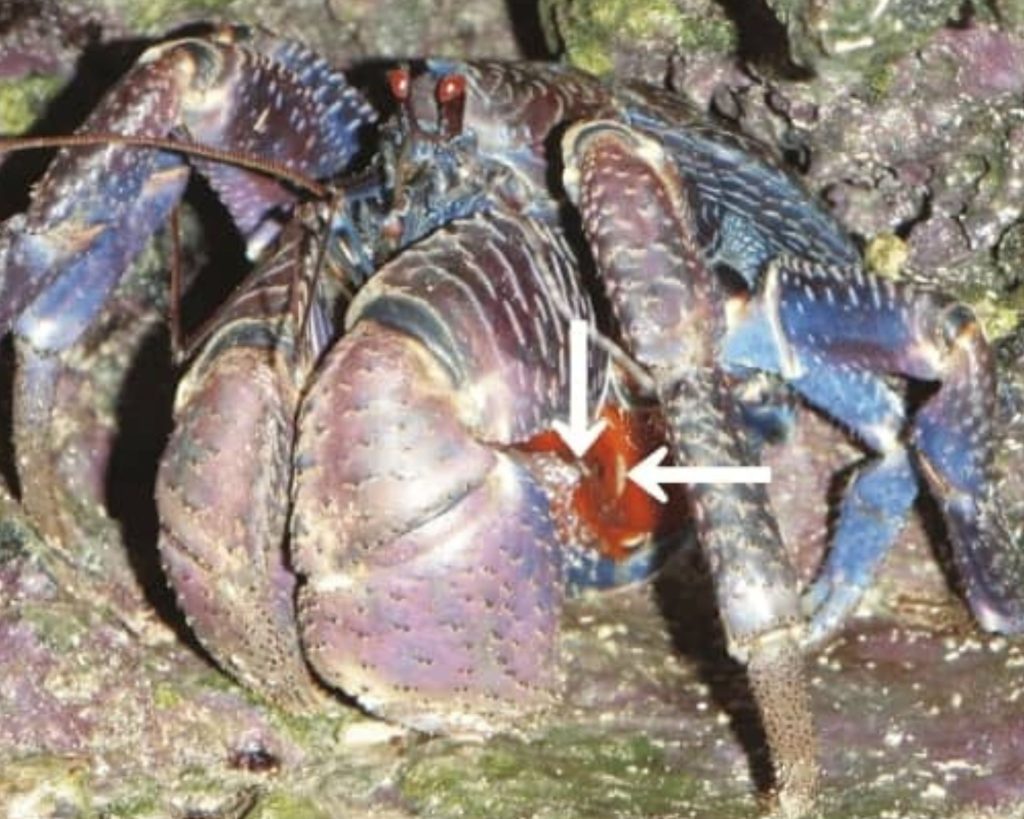
During the months of May through September, coconut crabs are most likely to engage in frequent and rapid mating on dry land, particularly between the beginning of June and the end of August. The oviducts-open at the base of the third pereiopods, and it is believed that fertilization takes-place on the external surface of the abdomen when the eggs pass through the spermatophore mass. Males have spermatophores, and they deposit a mass of spermatophores on the abdomens of females. The hatching of the young takes place on land, typically in crevices or burrows located close to the water’s edge. Shortly after mating, the female-lays-her eggs, which are then glued to the bottom of her belly. She continues to carry the fertilized eggs underneath her body for a few months after laying them. When it is time for the-eggs to hatch, the female coconut crab travels to the shoreline, where she discharges the newly hatched larvae into the water. Because coconut crabs are unable to swim, the female coconut crab risks a significant risk when she lays her eggs. The weight of a coconut crab makes it difficult or impossible for it to swim back to dry land in the event that it is swept away by the current or accidentally falls into the sea. The laying of eggs typically takes place on rocky coasts at dusk, and it is more common when this time of day coincides with high tide. After the larvae have been expelled from the egg cases, the egg cases continue to remain on the body of the female, and within a few days, the female consumes the egg cases. During the three to four weeks that the larvae spend floating around in the pelagic zone of the ocean with other plankton, a significant proportion of them are consumed by various types of predators. This process can take anywhere from 25-to-33 days and involves the larvae progressing through three to five zoea stages before finally moulting into the postlarval glaucothoe stage. As soon as they reach the glaucothoe stage of development, they descend to the ocean floor, search for a gastropod shell of an appropriate size, and then migrate to the seashore alongside other species of terrestrial hermit crabs. During this period, they occasionally travel to the dry land. After that, they are no longer able to breathe while submerged in water and are forced to leave the ocean forever. They go through the same process that happens with other hermit crabs when they change their shells. Young coconut crabs who are unable to find a seashell of the appropriate size frequently resort to using chunks of cracked coconut instead. As they mature, they shed their protective shells and develop a more robust abdominal wall. Approximately five years after hatching, the coconut crab will reach the age of sexual maturity. They don’t attain their full size until after 40–60 years have passed. According to the estimates of ecologist Michelle Drew of the Max Planck Institute, it could take up to one hundred and twenty years for it to reach its mature size. It develops extremely slowly.

The range of coconut palms and coconut crabs is quite similar, with coconut crabs inhabiting the Indian Ocean and the central Pacific Ocean. Zanzibar, which is located-off the coast of Tanzania, serves as the western boundary of the range of B. latro. The tropics of Cancer and Capricorn serve as the northern and southern boundaries of this species’ range, respectively; very few populations can be found in the subtropics, such as in the Ryukyu Islands. There is evidence that the coconut crab used to reside on the mainlands of Australia, Madagascar, Rodrigues, Easter Island, Tokelau, and maybe the Marquesas islands; however, it has since been extinct in those regions. Because adults are unable to swim, coconut crabs must have colonized the islands as planktonic larvae when they first arrived. Although it is outnumbered on Christmas Island by more than 50 times by the Christmas Island red crab, Christmas-Island is home to the world’s largest and densest colony of coconut crabs. Christmas Island is located in the Indian Ocean (Gecarcoidea natalis). Other populations from the Indian Ocean can be found in Seychelles; these populations include Aldabra and Cosmoledo; however, the coconut crab has become extinct on the central islands. There are populations of coconut crabs on a number of the Andaman and Nicobar Islands, which are located in the Bay of Bengal. They can be found on the majority of the Chagos Archipelago’s islands, as well as the atolls in the archipelago’s north. The territory in which the coconut crab is found in the Pacific was only gradually discovered. Charles Darwin was under the impression that it could only be located on “a solitary coral island north of the Society group.” Although it is much more common, the coconut crab does not always thrive in large numbers on each of the Pacific islands it occupies. The Cook Islands are home to a sizeable population of this species, particularly on the islands of Pukapuka, Suwarrow, Mangaia, Takutea, Mauke, Atiu, and Palmerston. These are very close to the eastern boundary of its range, as are the Line Islands of Kiribati. The coconut crab is particularly common on Teraina (Washington Island) due to the large coconut palm forest that can be found on that island. The Gambier Islands serve as the eastern boundary of the species’ range.
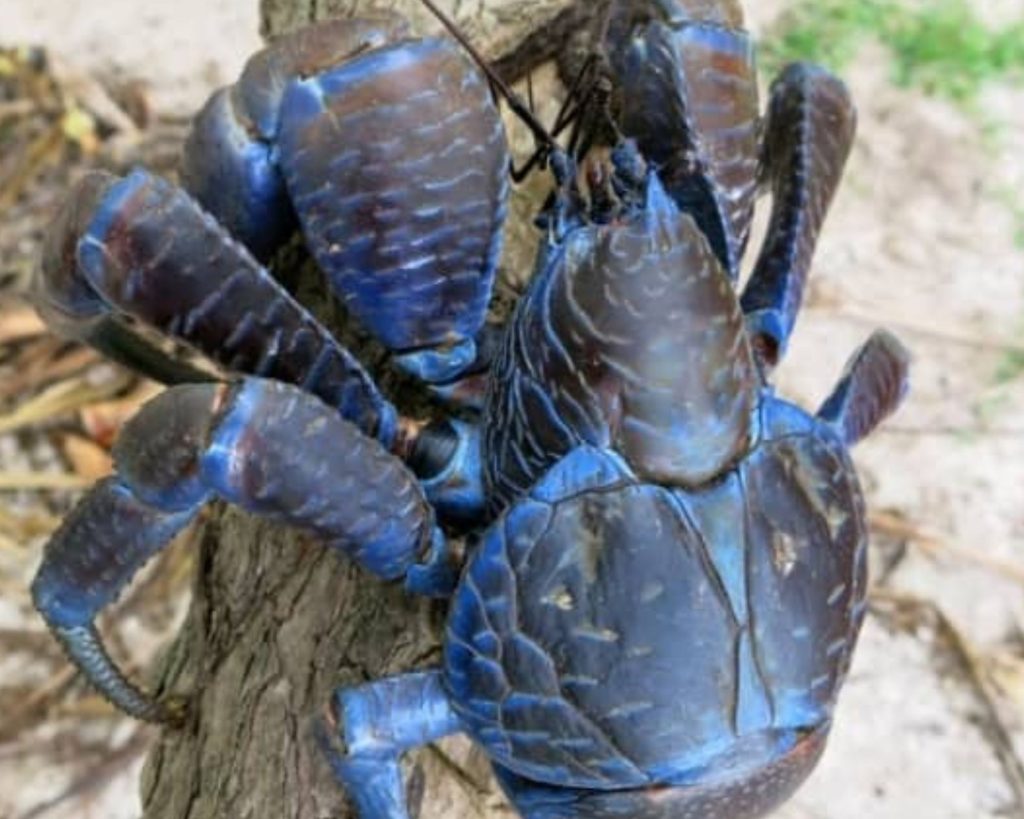
Fleshy fruits (especially Ochrosia ackeringae, Arenga listeri, Pandanus elatus, and P. christmatensis); nuts (Aleurites moluccanus), drupes (Cocos nucifera), and seeds (Annona reticulata); and the pith of dead trees are the primary components of a coconut crab’s diet. The fact that they are omnivores, however, means that they will ingest other forms of organic matter, such as hatchling tortoises and dead animals. Crabs like the Gecarcoidea Natalis and the Discoplax hirtipes have been seen as prey for these animals, and they have also been seen scavenging on the dead bodies of other species of coconut crabs. During the process of tagging animals, it was discovered that one coconut crab had killed and consumed a Polynesian rat (Rattus exulans). In the Chagos Archipelago in 2016, a huge coconut crab was seen climbing a tree in order to incapacitate and consume a red-footed booby. The incident took place. The coconut crab is able to pick up a coconut from the ground, rip it open to reveal the husked nut, carry the husked nut in its claw, climb up a tree that is 10 meters (33 feet) high, and then drop the husked nut in order to reach the coconut flesh that is contained within the coconut. They frequently descend from the trees via falling, and they are able to avoid injury even after falling at least 4.5 meters (15 feet). Coconut crabs use their powerful claws to make holes in coconuts and then consume the contents of the coconuts, even though it may take several days for the coconut to open up completely. In 1877, Thomas Hale Streets wrote about the behaviour and expressed his scepticism regarding the notion that the animal would climb trees in order to obtain coconuts. By seeing and researching the process of cracking open coconuts in the wild in the 1980s, Holger Rumpf was able to validate the findings of Streets’ report. If the-coconut is still covered with husk, the animal will use its claws to ri-off strips, always-starting from the side with the three germination-pores, which is a group-of three small-circles found on the outside of the coconut. If the husk has already been removed from the coconut, the animal will not use its claws to remove the husk. After the pores have become visible, the coconut crab will use its pincers to repeatedly hit one of the pores until it is destroyed. After that, it flips itself over and utilizes the smaller pincers on the other legs to pull the white flesh out of the coconut using its other legs. Larger individuals may even crack the tough coconut into smaller pieces, making it much simpler for them to consume. They do this by using their powerful-claws.
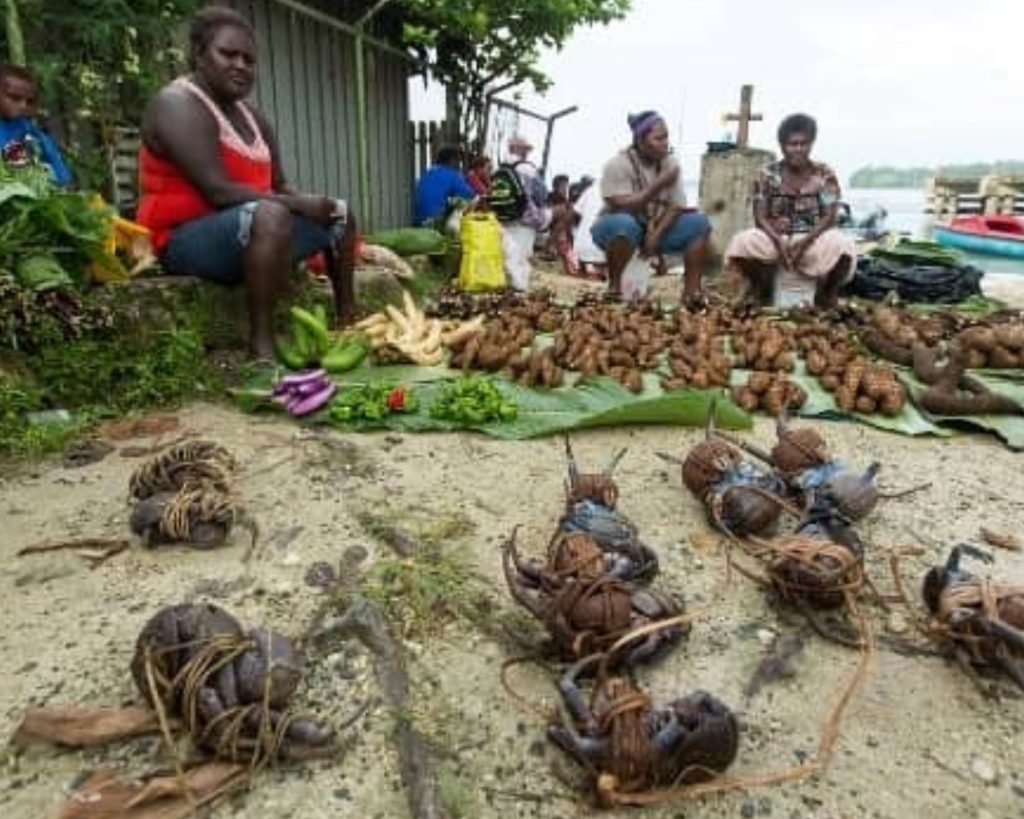
Habitat
There is a wide range of size and colours of coconut crabs. The coconut crab is one of the decapods that is believed to be one of the most terrestrially adapted due to the fact that the majority of its life is oriented to, and concentrated around, such an existence. Coconut crabs will actually perish in less than a day if they are submerged in salt water. Depending on the topography of their Habitat, coconut crabs either dwell alone in burrows or in rock crevices. They use sand or soil that is relatively loose to dig their own burrows. The animal keeps hidden during the day to prevent excessive loss of water due to the heat. The coconut crab uses the very fine yet resilient fibres of the coconut husk as bedding in its burrows, which are found within the coconut crab’s tunnels. The coconut crab uses one of its claws to seal off the entrances to its burrow while it is at rest. This helps to maintain the moist microclimate within the burrow, which is essential for the proper operation of the crab’s respiratory organs. When there is a significant population of coconut crabs in a region, it is possible that some of them will come out during the day, possibly to gain an edge when foraging for food. At other times, they come out when there is moisture in the air or when it is raining since these conditions make it easier for them to breathe. On Christmas Island, for example, B. latro is plentiful six kilometres (three and one-half miles) from the sea, even though they spend their entire lives practically on land and only return to the water to deliver their eggs.
Relationship with humans
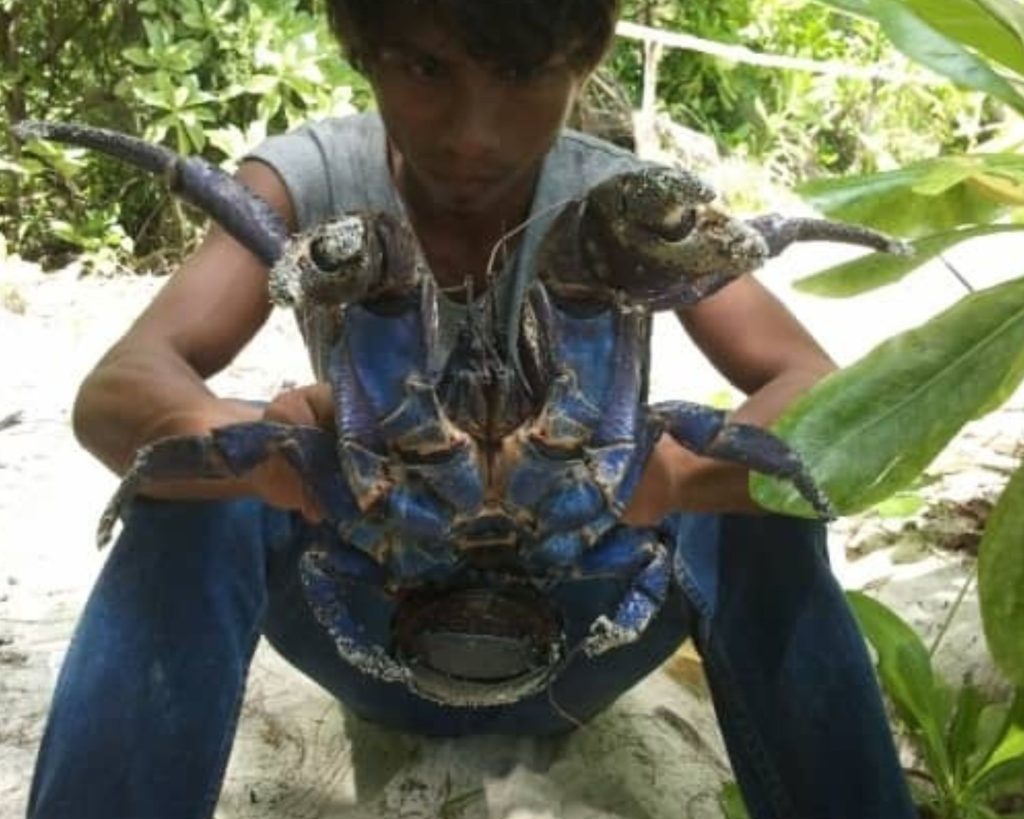
Adult coconut crabs have no known natural enemies, and the only other species that can harm them are other coconut crabs and humans. Because of its great size and the high quality of its meat, the coconut crab is subject to intense hunting pressure, and as a result, it is nearly extinct on islands that have a significant human population. On a number of different islands, the coconut crab is considered a delicacy and is also revered as an aphrodisiac. However, extensive hunting in certain regions has put the species’ ability to survive in jeopardy. There have-been reports of people getting sick from eating coconut crab, despite the fact that the coconut crab itself is not inherently dangerous. However, the crab’s diet can cause it to become poisonous. For example, if a coconut crab consumes sea mango, also known as Cerbera mangas, which contains cardiac cardenolides, the coconut crab may become poisonous. The pincers of the coconut crab are strong enough to cause a human to experience noticeable pain, and the coconut crab frequently maintains its grip for extended periods of time. It may be interesting to note-that in such a predicament, mild titillation of the under soft areas of the body with any light material may force the crab to lose its hold, according to Thomas Hale Streets, who says that the Micronesians of the Line Islands utilized this strategy. In the Cook-Islands, the coconut crab is known as UNGA or kaveu, and in the Mariana Islands, it is called ayuyu. The coconut crab is sometimes associated with taotaomo’na due to the traditional-belief that ancestral-spirits can-return in the form of animals such as the coconut-crab. In the Cook Islands, UNGA is the more common name for the coconut crab.
Conservation
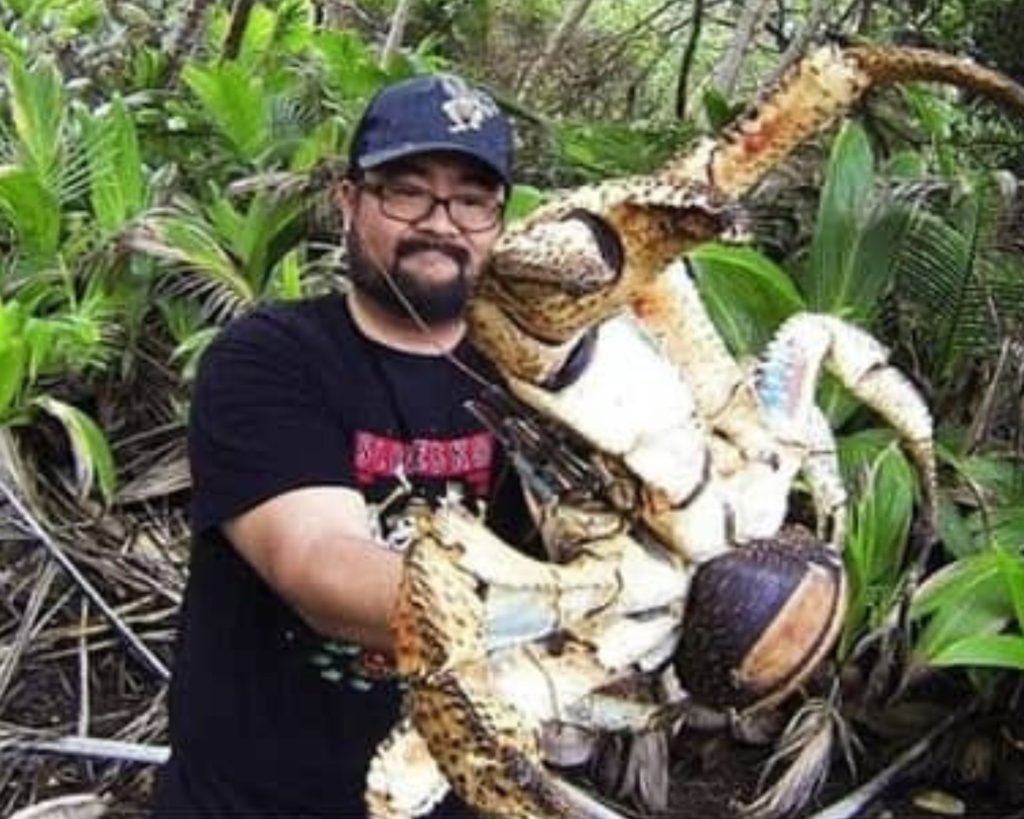
Both the destruction of their natural-habitats and the activities of humans have led to a reduction in the number of coconut crab populations or even to their extinction in some regions. Due-to a lack of available biological data, its status on the IUCN Red List was changed from that of a vulnerable species in 1981 to that of “data deficient” in 1996. However, it was originally given the vulnerable designation in 1981. The IUCN revised their evaluation in 2018, changing it to “vulnerable.” In some areas, conservation management strategies have been implemented, such as minimum legal-size limit restrictions in Guam, Vanuatu and a ban on the capture of egg-bearing females in Guam and the Federated-States of Micronesia. These measure have been taken in an effort to protect the species and ensure its continued existence. Hunting of non-egg-bearing adults with carapaces measuring more than 76 millimetres (three inches) in length is permitted in the Northern Mariana Islands during the months of September, October, and November, but only with a valid hunting license. On any given day, you’re only allowed to bring home a maximum of five coconut crabs, and the season’s total bag restriction is 15.
Could you go and check my other article also?

